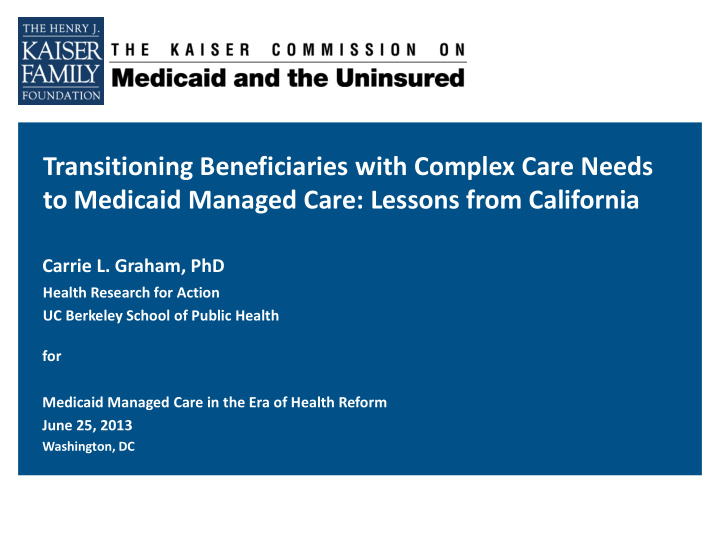



Transitioning Beneficiaries with Complex Care Needs to Medicaid Managed Care: Lessons from California Carrie L. Graham, PhD Health Research for Action UC Berkeley School of Public Health for Medicaid Managed Care in the Era of Health Reform June 25, 2013 Washington, DC
Figure 1 Expansion of Medicaid Managed Care in California (1115 Bridge to Reform Waiver) • Transition of Seniors and People with Disabilities (SPDs) from FFS to Medi- Cal managed care – 240,000 Medi-Cal-only SPD beneficiaries transitioned in 12 months – Medi-Cal-only SPDs= 16% seniors, 73% adults with disabilities* – 24% of the population, but 42% of FFS Medi-Cal expenditures – 66% receive treatment for 3+ conditions; 38% receive treatment for >6 conditions in one year* • Low Income Heath Program (LIHP) – Expands Medi-Cal to individuals up to 200% FPL – Over 85% of LIHP enrollees are in counties with Medi-Cal managed care • Cal MediConnect – Beneficiaries eligible for both Medicare and Medi-Cal (dual eligible beneficiaries) – 456,000 beneficiaries will be enrolled in Cal MediConnect plans beginning January 2014 *California Department of Health Care Services. The transfer of Medi-Cal Seniors and Persons with Disabilities to the Managed care delivery model , power point presentation (August, 2011).
Figure 2 Study Approach • Methods – 59 telephone interviews with medical providers, health plans, advocacy groups, and community-based organizations (CBOs) serving SPDs – Contra Costa, Kern, and Los Angeles Counties • Objectives – Examine how the transition to managed care affected care delivery for Medi-Cal-only SPDs; – Identify challenges faced by health plans, CBOs, and providers during the SPD transition; – Identify potential strategies and lessons learned; and – Inform future managed care transitions.
Figure 3 Transition Readiness: Data and Information Sharing The transition necessitated sharing of data and information across many entities. • DHCS beneficiaries ‒ Notification of switch/choice forms ‒ Consumer protections • DHCS health plans ‒ Beneficiary contact info ‒ Medical and prescription histories • Health plans beneficiaries ‒ Send new member card ‒ Conduct Health Risk Assessment ‒ Education about health plan navigation • Health plans providers ‒ Health Risk Assessment results ‒ Beneficiary medical and prescription histories ‒ Provider education and training • Provider provider ‒ PCP and specialists ‒ PCP and mental health providers
Figure 4 Transition Readiness: Data and Information Sharing • Challenges for state and health plans – Incomplete beneficiary contact information – Health history not provided soon enough to guide provider recruitment or assignment of non-choosing beneficiaries • Challenges for providers – Medical and prescription histories didn’t arrive in time for first appointment – Information in the health risk assessment was not useful to providers • Strategies to improve data and information sharing – Work with other county organizations or CBOs to reach out to beneficiaries – Allow for a 60-day waiting period between enrollment and using a plan to allow for transfer of medical histories
Figure 5 Developing Adequate Provider Networks • Challenges to network expansion – Difficulty recruiting primary care providers with expertise in complex care management – Difficulty recruiting specialists – FFS Medi-Cal doctors reluctant to join managed care • Strategies to improve provider recruitment – Market the benefits of managed care to providers – Incentivize providers to join Medi-Cal managed care plans • Higher reimbursement, P4P, streamlined paperwork – Transfer beneficiary utilization data early to target provider recruitment
Figure 6 Increased Strains on Organizational Resources • Challenges for health plans – Reimbursement rates don’t reflect utilization of mandatory SPDs – SPD Beneficiaries call member services line 4x as often as others • Challenges for providers – Already over burdened practices take on more SPD patients – Providers lack expertise with the complex care needs of SPD patients – Patients with greater need for urgent care/same day appointments/more frequent appointments – Providers providing uncompensated care for beneficiaries in active treatment • Challenges for CBOs – Provided assistance to beneficiaries during transition but were not compensated • Strategies to ease organizational strain – Collaborations across organizations to pool resources – Restructure appointment scheduling for more urgent care – Provide automatic delays or exemptions for beneficiaries in active treatment
Figure 7 Increased Need for Care Coordination • Health Plans, providers, and CBOs increased care coordination, but the transition created the need for more • Challenges for primary care providers – Spending more time on authorizations and denials – Not trained in care coordination • Challenges for health plans – Increase in use of member services lines, need to expand member service hours • Challenges for CBOs – Often the front lines of serving SPDs, but not reimbursed for time spent on care coordination • Strategies for improvement – Training for PCPs and other staff for authorizations and appealing denials – Collaboration with organizations that serve specific segments of SPD population
Figure 8 Looking Ahead • Though managed care has the potential to improve care in the long run, transitions of beneficiaries with complex care needs can cause initial disruptions in care. • Key steps can help ensure plan and provider readiness – Early transfer of beneficiary FFS utilization data – Anticipate challenges to expanding provider networks – Anticipate changes to beneficiary population – Restructure organizational resources – Develop partnerships across entities serving SPDs
Recommend
More recommend